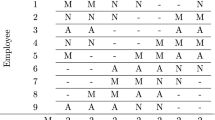Abstract
We consider a personalized employee scheduling problem with characteristics present in retail stores consisting of multiple departments. In the setting under study, each department generally covers its demand in employees over the planning horizon of a week by assigning shifts to its own staff. However, the employees can also be transferred to other departments under certain conditions for executing entire shifts or parts of shifts there. The transfer feature enables to improve the overall schedule quality considerably when compared to the nontransfer case. Given the complexity of the problem, we propose a three-phase decomposition-based heuristic. In the first phase, we consider each department separately and solve a simplified version of the mono-department scheduling problems. From the obtained solutions, we deduce inter-department shifts that could potentially reduce the overall cost. This is examined in the second phase by resolving the scheduling problem of the first phase where the deduced inter-department shifts are included. In this phase, however, we decompose the scheduling problem by time, looking at each day separately. From the obtained schedules, we then devise inter-department demand curves, which specify the number of transfers between departments over time. In the third phase, we decompose the initial scheduling problem into mono-department problems using these inter-department demand curves. Consequently, our approach makes it possible to solve mono-department optimization problems to get an overall schedule while still benefiting from the employee transfer feature. In all three phases, the scheduling problems are formulated as mixed-integer linear programs. We show through extensive computational experiments on instances with up to 25 departments and 1000 employees that the method provides high-quality solutions within reasonable computation times.









Similar content being viewed by others
References
Bard JF, Purnomo HW (2005) Hospital-wide reactive scheduling of nurses with preference considerations. IIE Trans 37(7):589–608
Bard JF, Wan L (2008) Workforce design with movement restrictions between workstation groups. Manuf Serv Oper Manag 10(1):24–42
Berman O, Larson RC, Pinker E (1997) Scheduling workforce and workflow in a high volume factory. Manag Sci 43(2):158–172
Bürgy R, Michon-Lacaze H, Desaulniers G (2018) Employee scheduling with short demand perturbations and extensible shifts. Omega. https://doi.org/10.1016/j.omega.2018.10.009
Côté M-C, Gendron B, Rousseau L-M (2013) Grammar-based column generation for personalized multi-activity shift scheduling. INFORMS J Comput 25(3):461–474
Dahmen S, Rekik M (2015) Solving multi-activity multi-day shift scheduling problems with a hybrid heuristic. J Sched 18(2):207–223
Dahmen S, Rekik M, Soumis F, Desaulniers G (2018) A two-stage solution approach for personalized multi-department multi-day shift scheduling. Technical report, Les Cahiers du GERAD G-2018-46
De Bruecker P, Van Den Bergh J, Beliën J, Demeulemeester E (2015) Workforce planning incorporating skills: state of the art. Eur J Oper Res 243(1):1–16
Desaulniers G, Desrosiers J, Gamache M, Soumis F (1998) Crew scheduling in air transportation. Chapter 8. In: Crainic TG, Laporte G (eds) Fleet management and logistics. Springer, Belin, pp 169–185
Ernst AT, Jiang H, Krishnamoorthy M, Sier D (2004) Staff scheduling and rostering: a review of applications, methods and models. Eur J Oper Res 153(1):3–27
Faaland B, Schmitt T (1993) Cost-based scheduling of workers and equipment in a fabrication and assembly shop. Oper Res 41(2):253–268
Hur D, Mabert VA, Bretthauer KM (2004) Real-time work schedule adjustment decisions: an investigation and evaluation. Prod Oper Manag 13(4):322–339
Kabak Ö, Ülengin F, Aktaş E, Önsel Ş, Topcu YI (2008) Efficient shift scheduling in the retail sector through two-stage optimization. Eur J Oper Res 184(1):76–90
Kasirzadeh A, Saddoune M, Soumis F (2017) Airline crew scheduling: models, algorithms, and data sets. EURO J Transp Log 6(2):111–137
Legrain A, Bouarab H, Lahrichi N (2015) The nurse scheduling problem in real-life. J Med Syst 39(1):160
Loucks JS, Jacobs FR (1991) Tour scheduling and task assignment of a heterogeneous work force: a heuristic approach. Decis Sci 22(4):719–738
Love RR Jr, Hoey JM (1990) Management science improves fast-food operations. Interfaces 20(2):21–29
Quimper C-G, Rousseau LM (2010) A large neighbourhood search approach to the multi-activity shift scheduling problem. J Heuristics 16(3):373–392
Sabar M, Montreuil B, Frayret J-M (2008) Competency and preference based personnel scheduling in large assembly lines. Int J Comput Integr Manuf 21(4):468–479
Souissi S (2016) Ré-optimisation d’horaires de personnel en ajoutant des transferts entre départements. Master’s thesis, École Polytechnique de Montréal
Thompson GM (2003) Labor scheduling: a commentary. Cornell Hotel Restaur Adm Q 44(5–6):149–155
Van den Bergh J, Beliën J, De Bruecker P, Demeulemeester E, De Boeck L (2013) Personnel scheduling: a literature review. Eur J Oper Res 226(3):367–385
Wright PD, Mahar S (2013) Centralized nurse scheduling to simultaneously improve schedule cost and nurse satisfaction. Omega 41(6):1042–1052
Author information
Authors and Affiliations
Corresponding author
Additional information
Publisher's Note
Springer Nature remains neutral with regard to jurisdictional claims in published maps and institutional affiliations.
This work was funded by Kronos Canadian Systems and the Natural Sciences and Engineering Research Council (NSERC) of Canada under Grant RDCPJ 468716 - 14. The financial support is greatly appreciated.
Appendix
Appendix
The detailed computational results are presented in Tables 3 and 4. The former gives the results obtained with our main experimental setting and is structured as follows. The instance names are given in the first column. For each instance, the solution value and the total computation time are specified for each of the four runs (global-noTrans, global, MP-DH, and MP-DH-noP1). The instances are grouped and sorted according to their size. Table 4 presents the results obtained in the setting of Dahmen et al. (2018) using a similar structure as in Table 3. It shows the solution values and computation times of our runs with MP-DH and MP-DH-noP1 as well as the benchmark values of Dahmen et al. (2018) obtained with their integrated heuristic (IH) and the time decomposition heuristic (TDH).
Rights and permissions
About this article
Cite this article
Attia, D., Bürgy, R., Desaulniers, G. et al. A decomposition-based heuristic for large employee scheduling problems with inter-department transfers. EURO J Comput Optim 7, 325–357 (2019). https://doi.org/10.1007/s13675-019-00119-3
Received:
Accepted:
Published:
Issue Date:
DOI: https://doi.org/10.1007/s13675-019-00119-3
Keywords
- Employees scheduling
- Shift scheduling
- Multi-department
- Retail industry
- Heterogeneous workforce
- Mixed-integer linear programming
- Decomposition




